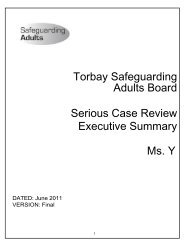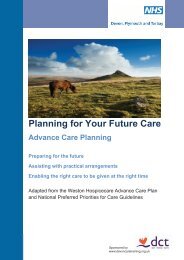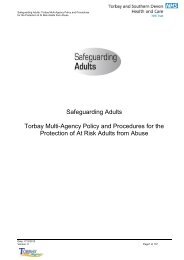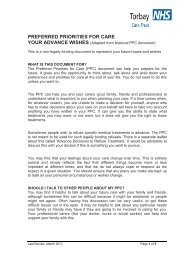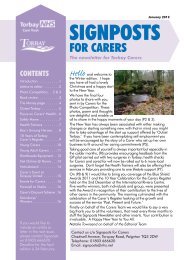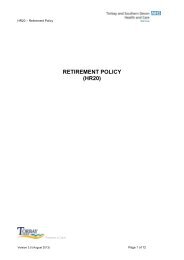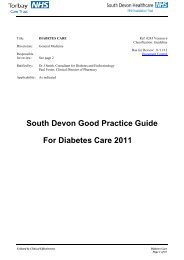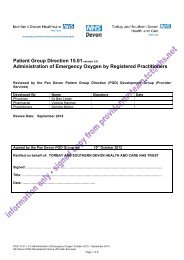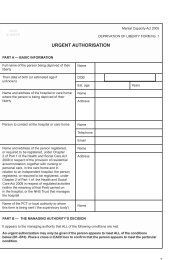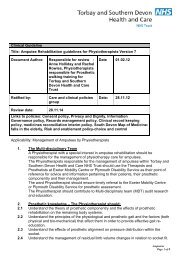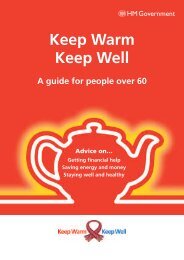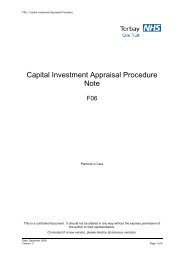a guide for professionals in health and social care - Torbay Care Trust
a guide for professionals in health and social care - Torbay Care Trust
a guide for professionals in health and social care - Torbay Care Trust
You also want an ePaper? Increase the reach of your titles
YUMPU automatically turns print PDFs into web optimized ePapers that Google loves.
evices<br />
<strong>in</strong><br />
ractice<br />
a <strong>guide</strong> <strong>for</strong><br />
<strong>professionals</strong><br />
<strong>in</strong> <strong>health</strong> <strong>and</strong><br />
<strong>social</strong> <strong>care</strong><br />
Safeguard<strong>in</strong>g public <strong>health</strong>
© Crown copyright 2008<br />
A fully revised edition of Devices <strong>in</strong> Practice,<br />
published 2001 <strong>and</strong> prepared by an<br />
Expert Work<strong>in</strong>g Group
Devices <strong>in</strong> Practice:<br />
a <strong>guide</strong> <strong>for</strong><br />
<strong>professionals</strong><br />
<strong>in</strong> <strong>health</strong> <strong>and</strong><br />
<strong>social</strong> <strong>care</strong><br />
Medic<strong>in</strong>es <strong>and</strong> Health<strong>care</strong><br />
products Regulatory Agency
Contents<br />
1 Introduction 3<br />
2 What is a medical device? 4<br />
Common types of medical device<br />
3 Procur<strong>in</strong>g medical devices 5<br />
Checklist: Procur<strong>in</strong>g medical devices<br />
The device<br />
Costs <strong>in</strong>curred<br />
Tra<strong>in</strong><strong>in</strong>g requirements<br />
4 Us<strong>in</strong>g medical devices safely 6<br />
Checklist: Us<strong>in</strong>g devices safely<br />
Be<strong>for</strong>e use: assessment<br />
Be<strong>for</strong>e use: knowledge of device<br />
Ask yourself<br />
Dur<strong>in</strong>g use<br />
After use<br />
Checklist: Advis<strong>in</strong>g service users <strong>and</strong> <strong>care</strong>rs<br />
5 Record keep<strong>in</strong>g 7<br />
Checklist: Record keep<strong>in</strong>g<br />
6 Ma<strong>in</strong>tenance <strong>and</strong> repair 8<br />
Checklist: Ma<strong>in</strong>tenance <strong>and</strong> repair<br />
7 Tra<strong>in</strong><strong>in</strong>g <strong>health</strong> <strong>and</strong> <strong>social</strong> 9<br />
<strong>care</strong> <strong>professionals</strong><br />
Checklist: Content of tra<strong>in</strong><strong>in</strong>g programmes<br />
8 The importance of report<strong>in</strong>g 10<br />
concerns about devices <strong>and</strong><br />
adverse <strong>in</strong>cidents<br />
What is an adverse <strong>in</strong>cident?<br />
Checklist: If an <strong>in</strong>cident occurs, what<br />
should I do?
1 Introduction<br />
Medical devices play a crucial role <strong>in</strong> <strong>care</strong><br />
<strong>and</strong> treatment. The number <strong>and</strong> variety of<br />
medical devices is vast <strong>and</strong> <strong>professionals</strong><br />
h<strong>and</strong>le a wide range of devices every day <strong>in</strong><br />
their practice. As the Agency responsible <strong>for</strong><br />
mak<strong>in</strong>g sure that medical devices are safe<br />
<strong>and</strong> fit <strong>for</strong> purpose, the Medic<strong>in</strong>es <strong>and</strong><br />
Health<strong>care</strong> products Regulatory Agency<br />
(MHRA) has prepared this booklet which<br />
provides a practical <strong>guide</strong> to medical devices<br />
<strong>for</strong> all <strong>health</strong> <strong>and</strong> <strong>social</strong> <strong>care</strong> <strong>professionals</strong>,<br />
<strong>and</strong> pharmacists work<strong>in</strong>g <strong>in</strong> acute, primary<br />
<strong>care</strong>, <strong>and</strong> <strong>social</strong> <strong>care</strong> sectors.<br />
This booklet is <strong>for</strong>:<br />
• <strong>health</strong> <strong>and</strong> <strong>social</strong> <strong>care</strong> <strong>professionals</strong> work<strong>in</strong>g<br />
<strong>in</strong> all areas <strong>in</strong>clud<strong>in</strong>g acute <strong>care</strong>, primary <strong>care</strong>,<br />
community <strong>care</strong> (or <strong>care</strong> at home), <strong>care</strong><br />
homes, <strong>care</strong> homes with nurs<strong>in</strong>g <strong>and</strong> private<br />
<strong>health</strong><strong>care</strong> systems<br />
• <strong>health</strong> <strong>and</strong> <strong>social</strong> <strong>care</strong> organisations as they<br />
develop policies <strong>and</strong> protocols <strong>for</strong> the use<br />
<strong>and</strong> management of medical devices<br />
• pharmacists <strong>in</strong> acute, primary <strong>care</strong> <strong>and</strong> <strong>social</strong><br />
<strong>care</strong> sett<strong>in</strong>gs<br />
• voluntary <strong>and</strong> charitable organisations who<br />
provide devices direct to <strong>in</strong>dividuals or <strong>health</strong><br />
<strong>and</strong> <strong>social</strong> <strong>care</strong> organisations.<br />
It conta<strong>in</strong>s a series of practical checklists to help<br />
ensure <strong>in</strong><strong>for</strong>med procurement <strong>and</strong> the safe use<br />
of medical devices.<br />
Some <strong>in</strong>dividuals buy their own medical devices<br />
privately through pharmacies or other sources<br />
<strong>and</strong>, <strong>in</strong>creas<strong>in</strong>gly, on the Internet. In these<br />
circumstances it is the responsibility of the owner<br />
to ensure that the medical devices are<br />
appropriately used, ma<strong>in</strong>ta<strong>in</strong>ed <strong>and</strong> ultimately<br />
disposed of.<br />
Back to Contents<br />
3<br />
Devices <strong>in</strong> Practice, MHRA, August 2008
2 What is a medical device?<br />
The term ‘medical device’ covers a wide range<br />
of <strong>health</strong><strong>care</strong> products other than medic<strong>in</strong>es<br />
used every day <strong>in</strong> all <strong>health</strong><strong>care</strong> sett<strong>in</strong>gs.<br />
A medical device is any product used <strong>in</strong> the:<br />
• diagnosis, prevention, monitor<strong>in</strong>g <strong>and</strong><br />
treatment of disease or disability<br />
• diagnosis, monitor<strong>in</strong>g, treatment, alleviation<br />
of or compensation <strong>for</strong> an <strong>in</strong>jury or h<strong>and</strong>icap<br />
• <strong>in</strong>vestigation, replacement or modification of<br />
the anatomy, or of a physiological process<br />
• control of conception.<br />
A list of some of the products covered by the<br />
def<strong>in</strong>ition of medical device is provided opposite.<br />
Go to list<br />
4<br />
Devices <strong>in</strong> Practice, MHRA, August 2008
3 Procur<strong>in</strong>g medical devices<br />
A policy <strong>for</strong> procur<strong>in</strong>g medical devices should be<br />
established <strong>in</strong> consultation with the <strong>professionals</strong><br />
who will be prescrib<strong>in</strong>g or supply<strong>in</strong>g them <strong>and</strong><br />
also with those who will be us<strong>in</strong>g the devices.<br />
The follow<strong>in</strong>g factors should be considered <strong>in</strong><br />
develop<strong>in</strong>g a policy:<br />
• what equipment <strong>and</strong> accessories need to be<br />
provided <strong>and</strong> why<br />
If medical devices are purchased from the<br />
Internet, <strong>care</strong> should be taken to purchase only<br />
from recognised sites <strong>and</strong> purchasers should<br />
check that equipment has been subject to<br />
regulatory assessment.<br />
Go to Checklist<br />
• the range of particular devices available to<br />
cover requirements<br />
• purchas<strong>in</strong>g arrangements <strong>for</strong> br<strong>in</strong>g<strong>in</strong>g <strong>in</strong> new<br />
types of devices<br />
• suitability <strong>for</strong> be<strong>in</strong>g sold or supplied by the<br />
NHS directly to members of the public<br />
without a professional <strong>in</strong>volved <strong>in</strong> the<br />
h<strong>and</strong>over, <strong>for</strong> example if supplied by a<br />
manufacturer or a store<br />
• the tender<strong>in</strong>g process <strong>for</strong> equipment supply,<br />
<strong>and</strong>, where applicable, ma<strong>in</strong>tenance<br />
• what is <strong>in</strong>cluded <strong>in</strong> a procurement package,<br />
e.g. device, accessories, consumables,<br />
backup, tra<strong>in</strong><strong>in</strong>g, servic<strong>in</strong>g <strong>and</strong> ma<strong>in</strong>tenance<br />
requirements <strong>and</strong> end of lifecycle<br />
replacement/disposal timescales <strong>and</strong><br />
procedures<br />
• total cost cover<strong>in</strong>g the device’s <strong>in</strong>tended<br />
lifecycle<br />
• compatibility with accessories <strong>and</strong> other<br />
devices if relevant<br />
• a system of record keep<strong>in</strong>g to <strong>in</strong>clude use,<br />
ma<strong>in</strong>tenance <strong>and</strong> track<strong>in</strong>g<br />
• degree of future proof<strong>in</strong>g of devices (i.e. is<br />
someth<strong>in</strong>g go<strong>in</strong>g to be available shortly that<br />
will be much better).<br />
5<br />
Devices <strong>in</strong> Practice, MHRA, August 2008
4 Us<strong>in</strong>g medical devices safely<br />
Professionals <strong>in</strong> <strong>health</strong> <strong>and</strong> <strong>social</strong> <strong>care</strong> use<br />
medical devices themselves <strong>and</strong> also provide<br />
devices which are then used by others, such as<br />
service users or <strong>care</strong>rs. Professionals <strong>in</strong> <strong>health</strong><br />
<strong>and</strong> <strong>social</strong> <strong>care</strong> are personally accountable <strong>for</strong><br />
their use of devices <strong>and</strong> there<strong>for</strong>e must ensure<br />
that they have appropriate tra<strong>in</strong><strong>in</strong>g. They are also<br />
personally accountable <strong>for</strong> ensur<strong>in</strong>g service users<br />
<strong>and</strong> <strong>care</strong>rs have received appropriate tra<strong>in</strong><strong>in</strong>g <strong>and</strong><br />
know how to use the device that has been<br />
provided.<br />
An <strong>in</strong>dividual <strong>health</strong><strong>care</strong> professional who uses the<br />
device <strong>in</strong> a way not <strong>in</strong>tended, or aga<strong>in</strong>st manufacturer’s<br />
<strong>in</strong>structions may be liable <strong>for</strong> any consequences.<br />
Go to Checklist<br />
Service users <strong>and</strong> <strong>care</strong>rs<br />
Health <strong>and</strong> <strong>social</strong> <strong>care</strong> <strong>professionals</strong> will often<br />
provide medical devices to be used by service<br />
users <strong>and</strong> <strong>care</strong>rs. It is important to make sure<br />
that service users <strong>and</strong> <strong>care</strong>rs have adequate<br />
<strong>in</strong><strong>for</strong>mation about the use of the device. Health<br />
<strong>and</strong> <strong>social</strong> <strong>care</strong> <strong>professionals</strong> are personally<br />
accountable <strong>for</strong> ensur<strong>in</strong>g that service users <strong>and</strong><br />
<strong>care</strong>rs have appropriate tra<strong>in</strong><strong>in</strong>g <strong>in</strong> the use <strong>and</strong><br />
ma<strong>in</strong>tenance of the device provided.<br />
Individuals who buy a device over the counter or<br />
privately need to be made aware of their<br />
personal responsibility to ensure the device is<br />
appropriately used <strong>and</strong> ma<strong>in</strong>ta<strong>in</strong>ed.<br />
Go to Checklist<br />
6<br />
Devices <strong>in</strong> Practice, MHRA, August 2008
5 Record keep<strong>in</strong>g<br />
Good records are important <strong>in</strong> effective device<br />
management. Records should provide evidence<br />
of what the device is <strong>and</strong> where it came from, its<br />
serial or batch number, the ma<strong>in</strong>tenance record<br />
of the device <strong>and</strong> any tra<strong>in</strong><strong>in</strong>g carried out on how<br />
to use it properly.<br />
Paper-based systems can be used if you have<br />
only a few devices; a computer-based system<br />
may be better if you have a number of devices.<br />
Go to Checklist<br />
7<br />
Devices <strong>in</strong> Practice, MHRA, August 2008
6 Ma<strong>in</strong>tenance <strong>and</strong> repair<br />
Rout<strong>in</strong>e ma<strong>in</strong>tenance <strong>and</strong> planned preventative<br />
ma<strong>in</strong>tenance should make sure that your<br />
equipment will work safely when you need to use<br />
it, <strong>and</strong> should keep it operat<strong>in</strong>g safely throughout<br />
its work<strong>in</strong>g life. Lack of ma<strong>in</strong>tenance could lead<br />
to premature failure of the device <strong>in</strong> use.<br />
Go to Checklist<br />
8<br />
Devices <strong>in</strong> Practice, MHRA, August 2008
7 Tra<strong>in</strong><strong>in</strong>g <strong>health</strong> <strong>and</strong> <strong>social</strong> <strong>care</strong><br />
<strong>professionals</strong><br />
All practices <strong>and</strong> organisations <strong>in</strong> the public,<br />
<strong>in</strong>dependent <strong>and</strong> voluntary sectors must provide<br />
adequate arrangements <strong>for</strong> tra<strong>in</strong><strong>in</strong>g <strong>in</strong> the safe<br />
use of medical devices. This also <strong>in</strong>cludes<br />
agencies provid<strong>in</strong>g staff to the <strong>care</strong> sector.<br />
Employers are responsible <strong>for</strong> ensur<strong>in</strong>g that staff<br />
who use medical devices have appropriate tra<strong>in</strong><strong>in</strong>g.<br />
Equally, all <strong>health</strong><strong>care</strong> <strong>professionals</strong> <strong>and</strong> support<br />
workers have a personal responsibility <strong>and</strong><br />
accountability to ensure that they are tra<strong>in</strong>ed <strong>in</strong> the<br />
safe use of the medical devices they need to use.<br />
Assessment of tra<strong>in</strong><strong>in</strong>g needs<br />
An assessment of tra<strong>in</strong><strong>in</strong>g needs should be undertaken<br />
<strong>for</strong> <strong>in</strong>dividual staff <strong>and</strong> should address both<br />
cl<strong>in</strong>ical <strong>and</strong> technical matters. Tra<strong>in</strong><strong>in</strong>g should<br />
then be planned to meet the identified needs.<br />
This should <strong>in</strong>clude whether <strong>in</strong>dividual staff:<br />
• underst<strong>and</strong> the pr<strong>in</strong>ciples underly<strong>in</strong>g the use<br />
of devices<br />
• are familiar with the practical aspects of the<br />
devices they are likely to encounter<br />
• have had their competence assessed <strong>in</strong><br />
relation to the safe use of devices.<br />
Go to Checklist<br />
9<br />
Devices <strong>in</strong> Practice, MHRA, August 2008
8 The importance of report<strong>in</strong>g concerns<br />
about devices <strong>and</strong> adverse <strong>in</strong>cidents<br />
What is an adverse <strong>in</strong>cident?<br />
A device-related adverse <strong>in</strong>cident is an event<br />
which can produce, or has the potential to<br />
produce, unwanted effects <strong>in</strong>volv<strong>in</strong>g the safety<br />
of patients, users or other people. An adverse<br />
<strong>in</strong>cident can arise from shortcom<strong>in</strong>gs <strong>in</strong> the<br />
device, its accessories, its operat<strong>in</strong>g <strong>in</strong>structions,<br />
user practice, servic<strong>in</strong>g <strong>and</strong> ma<strong>in</strong>tenance <strong>and</strong><br />
conditions of use. Sometimes the <strong>in</strong>structions <strong>for</strong><br />
use or labell<strong>in</strong>g are unclear. Sometimes patients<br />
<strong>and</strong> practitioners do not use a device <strong>in</strong> the way<br />
<strong>in</strong> which the manufacturer <strong>in</strong>tended. Adverse<br />
<strong>in</strong>cidents can also be the result of user error.<br />
It is important to report all device-related adverse<br />
<strong>in</strong>cidents so that these can then be <strong>in</strong>vestigated<br />
thoroughly <strong>and</strong> action taken as appropriate to<br />
improve the device <strong>and</strong> protect other patients<br />
<strong>and</strong>/or users. Comprehensive guidance on<br />
report<strong>in</strong>g adverse <strong>in</strong>cidents is conta<strong>in</strong>ed <strong>in</strong><br />
Device Bullet<strong>in</strong> DB2008/(01) Report<strong>in</strong>g Adverse<br />
Incidents <strong>and</strong> Dissem<strong>in</strong>at<strong>in</strong>g Medical Device<br />
Alerts. This is published on the MHRA website<br />
<strong>and</strong> is updated annually.<br />
The preferred <strong>in</strong>cident report<strong>in</strong>g route is via<br />
the onl<strong>in</strong>e report<strong>in</strong>g system on the MHRA<br />
website: www.mhra.gov.uk<br />
Additionally advice on report<strong>in</strong>g may be<br />
obta<strong>in</strong>ed from the Adverse Incident Centre:<br />
Telephone: 020 7084 3080<br />
Email: aic@mhra.gsi.gov.uk<br />
Medical device safety warn<strong>in</strong>gs <strong>and</strong> advice are<br />
issued through Medical Device Alerts from the<br />
Medic<strong>in</strong>es <strong>and</strong> Health<strong>care</strong> products Regulatory<br />
Agency. You can subscribe to receive these via<br />
the website at: www.mhra.gov.uk<br />
Go to Checklist<br />
10<br />
Devices <strong>in</strong> Practice, MHRA, August 2008
Common types of medical device<br />
This list is not comprehensive but gives a sense of the range of products<br />
that are medical devices<br />
Devices used <strong>in</strong> the diagnosis or<br />
treatment of disease, or monitor<strong>in</strong>g<br />
of patients, such as:<br />
■ Anaesthetic mach<strong>in</strong>e<br />
■ Blood glucose measur<strong>in</strong>g devices<br />
■ Chiropody <strong>and</strong> podiatry equipment<br />
■ CT scanner<br />
■ Dental <strong>in</strong>struments, equipment <strong>and</strong> materials<br />
■ Dress<strong>in</strong>gs<br />
■ Endoscopes<br />
■ Exam<strong>in</strong>ation gloves<br />
■ Intravenous (IV) adm<strong>in</strong>istration sets <strong>and</strong> pumps<br />
■ Nebulisers<br />
■ Ophthalmic equipment<br />
■ Pacemakers<br />
■ Peak flow meters<br />
■ Surgical <strong>in</strong>struments<br />
■ Suction equipment<br />
■ Syr<strong>in</strong>ges <strong>and</strong> needles<br />
■ Ultrasound dopplers<br />
■ Ur<strong>in</strong>ary catheters<br />
Devices used <strong>in</strong> life support, such as:<br />
■ Defibrillators<br />
■ Patient monitors<br />
■ Pulse oximeters<br />
■ Ventilators<br />
In vitro diagnostic medical devices<br />
<strong>and</strong> their accessories, such as:<br />
■ Blood glucose measur<strong>in</strong>g devices<br />
■ Cholesterol test kits<br />
■ Pregnancy test kits<br />
■ Ur<strong>in</strong>e test strips<br />
Devices used <strong>in</strong> <strong>care</strong>, such as:<br />
■ Adjustable beds<br />
■ Lift<strong>in</strong>g poles<br />
■ Patient hoists <strong>and</strong> other transfer equipment<br />
■ Pressure relief equipment<br />
■ Stoma <strong>care</strong> equipment<br />
Equipment used by people with<br />
disabilities, such as:<br />
■ Bath<strong>in</strong>g equipment<br />
■ Commodes<br />
■ Communication aids<br />
■ External prostheses <strong>and</strong> orthoses<br />
■ Hear<strong>in</strong>g aids<br />
■ Incont<strong>in</strong>ence aids<br />
■ Prescribable footwear<br />
■ St<strong>and</strong><strong>in</strong>g frames<br />
■ Tele<strong>care</strong> (environmental controls <strong>and</strong> alarms)<br />
■ Ur<strong>in</strong>e dra<strong>in</strong>age systems<br />
■ Walk<strong>in</strong>g aids<br />
■ Wheelchairs <strong>and</strong> special support seat<strong>in</strong>g<br />
Devices supplied by pharmacists<br />
■ Condoms<br />
■ Contact lens <strong>care</strong> products<br />
■ Chlamydia test kits<br />
■ Cholesterol test kits<br />
■ Pregnancy test kits<br />
■ Sphygmomanometers<br />
■ Thermometers<br />
■ Stoma equipment<br />
■ Ur<strong>in</strong>e test strips<br />
Back to p4 or Contents<br />
11<br />
Devices <strong>in</strong> Practice, MHRA, August 2008
Checklist: Procur<strong>in</strong>g medical devices<br />
This checklist will help <strong>in</strong> mak<strong>in</strong>g a decision about procur<strong>in</strong>g the most appropriate device<br />
The device<br />
■ What functions must the device per<strong>for</strong>m?<br />
Consider its fitness <strong>and</strong> suitability <strong>for</strong> purpose. If the<br />
device is be<strong>in</strong>g purchased <strong>for</strong> a specific <strong>in</strong>dividual,<br />
consider if his/her cl<strong>in</strong>ical or physical condition<br />
contra<strong>in</strong>dicates its use<br />
■ What similar devices do we already have?<br />
Keep range of any type of device limited<br />
■ What is the evidence <strong>for</strong> the choice of this<br />
device?<br />
Consider whether any research on effectiveness<br />
has been carried out<br />
■ How easy is the device to use <strong>and</strong> ma<strong>in</strong>ta<strong>in</strong>?<br />
Previous experience, feedback from users<br />
■ What is the life expectancy of the device?<br />
■ Does it have multifunctionality, i.e. can it<br />
replace several not just one device<br />
■ Is a s<strong>in</strong>gle-use or a multiple-use device most<br />
appropriate?<br />
■ Has the device a CE mark<strong>in</strong>g?<br />
See note below<br />
■ What accessories are necessary <strong>for</strong> the<br />
<strong>in</strong>tended function of the device?<br />
Consider whether they are easy to obta<strong>in</strong> <strong>and</strong><br />
compatible with exist<strong>in</strong>g device<br />
■ Where is the device to be used?<br />
Consider location, e.g. <strong>health</strong> centre, <strong>care</strong> home or<br />
user’s home<br />
■ Are <strong>in</strong>fection control or decontam<strong>in</strong>ation<br />
processes required <strong>and</strong> are facilities available?<br />
Consider whether any <strong>in</strong>fection control or<br />
decontam<strong>in</strong>ation measures are needed<br />
CE mark<strong>in</strong>g means that the device meets the relevant<br />
regulatory requirements, per<strong>for</strong>ms as <strong>in</strong>tended,<br />
complies with the necessary requirement cover<strong>in</strong>g safety <strong>and</strong><br />
per<strong>for</strong>mance <strong>and</strong> is acceptably safe. In general, a medical<br />
device cannot be marketed <strong>in</strong> Europe without carry<strong>in</strong>g a CE<br />
mark<strong>in</strong>g. Custom-made devices <strong>and</strong> those under cl<strong>in</strong>ical<br />
<strong>in</strong>vestigation do not require CE mark<strong>in</strong>g.<br />
■ Where can unbiased <strong>in</strong><strong>for</strong>mation on the<br />
range of available devices be obta<strong>in</strong>ed?<br />
• consult documents, e.g. Centre <strong>for</strong> Evidencebased<br />
Purchas<strong>in</strong>g, Guidel<strong>in</strong>es <strong>and</strong> Audit<br />
Implementation Network (GAIN), Disabled Liv<strong>in</strong>g<br />
Foundation reports<br />
• consult National Association of Equipment<br />
Providers, servic<strong>in</strong>g contractors, hospital supplies<br />
departments, hospital specialists<br />
• seek advice from colleagues, professional<br />
associations, experts <strong>in</strong> the field<br />
Costs <strong>in</strong>curred<br />
■ What is the cost of the device <strong>and</strong><br />
<strong>in</strong>stallation, if applicable?<br />
■ What ma<strong>in</strong>tenance is required <strong>and</strong> what is the<br />
cost?<br />
■ Are ma<strong>in</strong>tenance <strong>and</strong> servic<strong>in</strong>g costs<br />
<strong>in</strong>cluded <strong>in</strong> the price?<br />
■ What are the purchase, lease <strong>and</strong> f<strong>in</strong>ance<br />
options?<br />
■ Is servic<strong>in</strong>g <strong>in</strong>surance cover available <strong>and</strong> at<br />
what cost?<br />
■ What is the cost of consumables?<br />
■ Does the device represent value <strong>for</strong> money?<br />
■ What is the cost of disposal?<br />
Tra<strong>in</strong><strong>in</strong>g requirements<br />
■ Are special cl<strong>in</strong>ical <strong>and</strong> technical tra<strong>in</strong><strong>in</strong>g<br />
requirements necessary?<br />
■ Are <strong>in</strong>itial <strong>and</strong> updat<strong>in</strong>g tra<strong>in</strong><strong>in</strong>g programmes<br />
provided by the manufacturer <strong>and</strong> have these<br />
been validated?<br />
■ Does the end user/patient require tra<strong>in</strong><strong>in</strong>g<br />
be<strong>for</strong>e the device is used?<br />
Back to p5 or Contents<br />
12 Devices <strong>in</strong> Practice, MHRA, August 2008
Checklist: Us<strong>in</strong>g devices safely<br />
Use this checklist to ensure that you use medical devices safely<br />
Be<strong>for</strong>e use: assessment<br />
■ What are the patient’s or client’s cl<strong>in</strong>ical <strong>and</strong><br />
<strong>social</strong> needs?<br />
■ Which of the medical devices available best<br />
meets those needs?<br />
■ Has a risk assessment been undertaken? Are<br />
the risks associated with this device<br />
acceptable <strong>and</strong> can they be m<strong>in</strong>imised?<br />
■ If the device has been bought privately is the<br />
patient or client aware of their personal<br />
responsibility?<br />
■ If the medical device is to be used by patients<br />
<strong>and</strong>/or <strong>care</strong>rs, have the follow<strong>in</strong>g been taken<br />
<strong>in</strong>to account:<br />
• physical capabilities – e.g. manual dexterity<br />
• sensory capabilities – e.g. vision, hear<strong>in</strong>g<br />
ability to underst<strong>and</strong> <strong>and</strong> remember<br />
• previous experience with the medical device<br />
• the patient’s or client’s expectations<br />
• the environment <strong>in</strong> which device will be used<br />
Be<strong>for</strong>e use: knowledge of device<br />
■ Is the device to be used <strong>in</strong> the way <strong>in</strong>tended<br />
by the manufacturer?<br />
■ What are the limitations <strong>and</strong> contra-<strong>in</strong>dications<br />
<strong>for</strong> use?<br />
■ Has the device been ma<strong>in</strong>ta<strong>in</strong>ed <strong>in</strong> l<strong>in</strong>e with<br />
the manufacturer’s <strong>in</strong>structions?<br />
■ Has the device been checked/calibrated after<br />
ma<strong>in</strong>tenance?<br />
■ Is the device with<strong>in</strong> its expiry or use-by date?<br />
■ Who is able to carry out pre-use checks?<br />
■ Are there any signs of wear, damage or faults?<br />
■ Where can a replacement device be obta<strong>in</strong>ed?<br />
Ask yourself:<br />
■ Do I know how to set up <strong>and</strong> use this device?<br />
■ Have I read the user <strong>in</strong>structions, <strong>and</strong> are they<br />
attached to the device [if this is possible]?<br />
■ Have I been tra<strong>in</strong>ed <strong>in</strong> its use?<br />
■ How was my competency <strong>in</strong> relation to this<br />
device assessed?<br />
Back to p6 or Contents<br />
■ Do I know how this device should per<strong>for</strong>m<br />
<strong>and</strong> the monitor<strong>in</strong>g that needs to be done to<br />
check its per<strong>for</strong>mance?<br />
■ Am I us<strong>in</strong>g the correct additional equipment, e.g.<br />
disposable <strong>in</strong>fusion sets <strong>for</strong> an <strong>in</strong>fusion pump?<br />
■ Do I know how to recognise whether the<br />
device has failed?<br />
■ Do I know what to do if the device fails?<br />
■ Do I know how <strong>and</strong> to whom to report a<br />
device-related adverse <strong>in</strong>cident?<br />
■ Has the device been modified, if so, has<br />
liability been checked with the manufacturer?<br />
■ In the case of devices purchased over the<br />
counter, have I advised the user to register with<br />
the manufacturer <strong>for</strong> ease of contact <strong>in</strong> case of<br />
urgent upgrades or recalls?<br />
Dur<strong>in</strong>g use<br />
■ Does check<strong>in</strong>g the medical device <strong>in</strong>dicate it<br />
is function<strong>in</strong>g correctly <strong>and</strong> to the<br />
manufacturer’s specifications?<br />
■ What action should be taken if the device is<br />
not function<strong>in</strong>g properly?<br />
■ Has this been documented?<br />
■ Is there up-to-date documentation to record<br />
regular check<strong>in</strong>g of the device?<br />
■ Have you documented the details (name <strong>and</strong><br />
serial number) of the device be<strong>in</strong>g used?<br />
■ Is the equipment still appropriate <strong>in</strong> the light of<br />
the patient or client’s chang<strong>in</strong>g needs?<br />
After use<br />
■ What clean<strong>in</strong>g <strong>and</strong>/or decontam<strong>in</strong>ation is<br />
required?<br />
■ Does the medical device show any signs of<br />
wear, damage or faults that should be reported?<br />
■ Is any servic<strong>in</strong>g, ma<strong>in</strong>tenance or repair<br />
required?<br />
■ Were there any problems <strong>in</strong> us<strong>in</strong>g this device<br />
which should be noted <strong>and</strong> could be rectified<br />
<strong>for</strong> the future? E.g. was any <strong>in</strong><strong>for</strong>mation<br />
miss<strong>in</strong>g from the patient/<strong>care</strong>r guidance which<br />
would have been useful?<br />
■ If used <strong>in</strong> the home, how will the medical<br />
device be returned to the owner, disposed of,<br />
or safely stored?<br />
13<br />
Devices <strong>in</strong> Practice, MHRA, August 2008
Checklist: Advis<strong>in</strong>g service users <strong>and</strong> <strong>care</strong>rs<br />
Use this checklist to make sure that service users <strong>and</strong> <strong>care</strong>rs are fully aware of their<br />
responsibility <strong>for</strong> medical devices<br />
■ Has the service user or <strong>care</strong>r been tra<strong>in</strong>ed <strong>in</strong><br />
the use of the device?<br />
■ Have they been given written guidance to<br />
support the use of the device <strong>and</strong> covers:<br />
• the name of the device<br />
• the operation of the device <strong>and</strong>, where<br />
fitted, accessories<br />
• their responsibility <strong>for</strong> check<strong>in</strong>g the device<br />
while <strong>in</strong> use<br />
• the ma<strong>in</strong>tenance required <strong>and</strong> its frequency<br />
• recognition of device failure <strong>and</strong> fault<br />
• action to be taken <strong>in</strong> the event of a device<br />
failure or fault<br />
• their responsibility <strong>for</strong> report<strong>in</strong>g an untoward<br />
event to the supplier of the equipment<br />
• telephone numbers of contact po<strong>in</strong>ts <strong>in</strong> an<br />
emergency, <strong>in</strong>clud<strong>in</strong>g out of hours<br />
• their responsibilities if they have bought the<br />
device themselves<br />
Back to p6 or Contents<br />
14
Checklist: Record keep<strong>in</strong>g<br />
Use this checklist to ensure your record keep<strong>in</strong>g is adequate<br />
Ensure that your records provide evidence of:<br />
■ a unique identification of the device, <strong>and</strong> its<br />
location where appropriate<br />
■ an appropriate history of the lifecycle of the<br />
device, <strong>in</strong>clud<strong>in</strong>g date of purchase <strong>and</strong><br />
<strong>in</strong>stallation<br />
■ meet<strong>in</strong>g any legal requirements concern<strong>in</strong>g the<br />
use of the device<br />
■ proper <strong>in</strong>stallation<br />
■ rout<strong>in</strong>e ma<strong>in</strong>tenance<br />
Your records should show that the end user:<br />
■ knows how to use the device safely<br />
■ can carry out day-to-day checks <strong>and</strong> rout<strong>in</strong>e<br />
ma<strong>in</strong>tenance<br />
■ has been tra<strong>in</strong>ed <strong>and</strong> had relevant refresher<br />
tra<strong>in</strong><strong>in</strong>g<br />
Back to p7 or Contents<br />
15<br />
Devices <strong>in</strong> Practice, MHRA, August 2008
Checklist: Ma<strong>in</strong>tenance <strong>and</strong> repair<br />
Use this checklist to ensure that your ma<strong>in</strong>tenance <strong>and</strong> repair systems are appropriate<br />
■ Rout<strong>in</strong>e ma<strong>in</strong>tenance will <strong>in</strong>clude:<br />
• regular clean<strong>in</strong>g of the device<br />
• preparation of the device <strong>for</strong> use<br />
• check<strong>in</strong>g <strong>and</strong> calibrat<strong>in</strong>g the device be<strong>for</strong>e<br />
<strong>and</strong> dur<strong>in</strong>g periods of use<br />
■ Procedures <strong>for</strong> rout<strong>in</strong>e ma<strong>in</strong>tenance should<br />
ensure that:<br />
• <strong>in</strong>structions are documented <strong>and</strong> available<br />
• the user knows the decontam<strong>in</strong>ation<br />
process <strong>for</strong> the device after use<br />
• devices are stored safely <strong>in</strong> accordance with<br />
the manufacturer’s <strong>in</strong>structions<br />
■ Planned preventative ma<strong>in</strong>tenance:<br />
• should follow the device manufacturer’s<br />
guidance<br />
• is usually done by the manufacturer, supplier<br />
or agent<br />
• may be done by third party repairers,<br />
provided the work of the sub-contractor is of<br />
a sufficiently high st<strong>and</strong>ard, is audited <strong>and</strong><br />
reviewed regularly<br />
■ Procedures <strong>for</strong> planned preventative<br />
ma<strong>in</strong>tenance should ensure that:<br />
• there is a contract which sets out<br />
responsibilities <strong>and</strong> repair <strong>and</strong> ma<strong>in</strong>tenance<br />
requirements<br />
• there is evidence to show that the service<br />
organisation is competent to ma<strong>in</strong>ta<strong>in</strong> the<br />
device to the manufacturer's specification<br />
• any changes to the manufacturer’s<br />
ma<strong>in</strong>tenance recommendations have been<br />
agreed <strong>and</strong> documented<br />
• follow<strong>in</strong>g ma<strong>in</strong>tenance or servic<strong>in</strong>g, the<br />
device is checked <strong>for</strong> safe function be<strong>for</strong>e it<br />
is used<br />
• there is a planned replacement policy<br />
• times <strong>for</strong> preventative ma<strong>in</strong>tenance on<br />
<strong>in</strong>dividual devices are brought to users’<br />
attention regularly <strong>and</strong> automatically<br />
• there is a system to display the date of the<br />
last <strong>and</strong> the next service, if this is<br />
appropriate<br />
■ Back-up equipment should be available if the<br />
device is defective or requires servic<strong>in</strong>g or<br />
ma<strong>in</strong>tenance<br />
Collection, storage, clean<strong>in</strong>g <strong>and</strong> decontam<strong>in</strong>ation of<br />
devices have safety implications not only <strong>for</strong> patients<br />
<strong>and</strong> users, but also <strong>for</strong> servic<strong>in</strong>g <strong>and</strong> ma<strong>in</strong>tenance<br />
personnel.<br />
Back to p8 or Contents<br />
16<br />
Devices <strong>in</strong> Practice, MHRA, August 2008
Checklist: Content of tra<strong>in</strong><strong>in</strong>g programmes<br />
Use this checklist to ensure that the key issues have been covered when receiv<strong>in</strong>g or<br />
develop<strong>in</strong>g tra<strong>in</strong><strong>in</strong>g programmes<br />
Programmes address<strong>in</strong>g general pr<strong>in</strong>ciples<br />
concern<strong>in</strong>g medical devices should <strong>in</strong>clude:<br />
■ relevant regulations<br />
■ the purpose <strong>in</strong>tended by the manufacturer<br />
■ per<strong>for</strong>mance specifications<br />
■ frequency of ma<strong>in</strong>tenance <strong>and</strong> servic<strong>in</strong>g<br />
■ checks required follow<strong>in</strong>g ma<strong>in</strong>tenance <strong>and</strong><br />
servic<strong>in</strong>g<br />
■ importance of comply<strong>in</strong>g with the<br />
manufacturer’s <strong>in</strong>structions <strong>for</strong> use<br />
■ sett<strong>in</strong>g up a device<br />
■ pre-use checks<br />
■ monitor<strong>in</strong>g <strong>and</strong> check<strong>in</strong>g dur<strong>in</strong>g use<br />
■ procedures (<strong>in</strong>clud<strong>in</strong>g local procedures) <strong>for</strong><br />
report<strong>in</strong>g an adverse <strong>in</strong>cident<br />
■ importance of clean<strong>in</strong>g <strong>and</strong> decontam<strong>in</strong>ation<br />
■ the importance of consult<strong>in</strong>g the manufacturer<br />
<strong>in</strong> the exceptional event of consider<strong>in</strong>g us<strong>in</strong>g<br />
or process<strong>in</strong>g the medical device <strong>in</strong> any way<br />
not covered by the manufacturer's <strong>in</strong>structions<br />
■ the importance of remov<strong>in</strong>g devices from use<br />
at the end of their lifecycle<br />
■ the importance of dispos<strong>in</strong>g of devices<br />
appropriately<br />
Back to p9 or Contents<br />
Programmes address<strong>in</strong>g the use of specific<br />
devices should <strong>in</strong>clude:<br />
■ purpose of the device<br />
■ pr<strong>in</strong>ciples of how it operates<br />
■ device specifications<br />
■ sett<strong>in</strong>g up the device<br />
■ safety features <strong>and</strong> the rationale <strong>for</strong> them<br />
■ reliance to be placed on the device<br />
■ reliance to be placed on results obta<strong>in</strong>ed from<br />
the device<br />
■ reliance to be placed on the safety features of<br />
the device<br />
■ importance of ‘double check<strong>in</strong>g’ by observ<strong>in</strong>g<br />
the patient <strong>and</strong> device<br />
■ use of any relevant alarms<br />
■ difficulties <strong>in</strong> the use of the specific device<br />
<strong>and</strong> any likely causes of failure<br />
■ monitor<strong>in</strong>g <strong>and</strong> check<strong>in</strong>g of device<br />
■ recognis<strong>in</strong>g when the device has failed<br />
■ common faults <strong>in</strong> the use of the device<br />
■ importance of the user consult<strong>in</strong>g the<br />
manufacturer’s <strong>in</strong>structions<br />
■ clean<strong>in</strong>g <strong>and</strong> decontam<strong>in</strong>ation<br />
■ assess<strong>in</strong>g competence <strong>in</strong> the safe use of the<br />
device<br />
17 Devices <strong>in</strong> Practice, MHRA, August 2008
Checklist: If an <strong>in</strong>cident occurs, what should<br />
I do?<br />
■ Check <strong>and</strong> take steps necessary <strong>for</strong> the<br />
wellbe<strong>in</strong>g of the patient<br />
■ Take device(s) <strong>in</strong>volved out of action, together<br />
with other material evidence, e.g. packag<strong>in</strong>g if<br />
available. Label the affected device. If this is<br />
not possible the state of the device at the time<br />
of <strong>in</strong>cident should be recorded<br />
■ Record:<br />
• date <strong>and</strong> time of the <strong>in</strong>cident<br />
• device sett<strong>in</strong>gs if relevant<br />
• details of <strong>in</strong>cident (how it happened <strong>and</strong> any<br />
outcomes <strong>for</strong> the person affected)<br />
• details of device affected <strong>and</strong> any others<br />
(type, make, model <strong>and</strong> serial numbers)<br />
• details of any error message or failures<br />
Back to p10 or Contents<br />
■ Report <strong>in</strong>cident to relevant manager <strong>and</strong> to<br />
the <strong>in</strong>cident centre <strong>in</strong> your country or listed<br />
below<br />
Engl<strong>and</strong> <strong>and</strong> Wales report to:<br />
Adverse Incident Centre<br />
Medic<strong>in</strong>es <strong>and</strong> Health<strong>care</strong> products<br />
Regulatory Agency<br />
Market Towers<br />
1 N<strong>in</strong>e Elms Lane<br />
London, SW8 5NQ<br />
Tel: 020 7084 3080<br />
Fax: 020 7084 3109<br />
E-mail: aic@mhra.gsi.gov.uk<br />
Report onl<strong>in</strong>e: www.mhra.gov.uk<br />
Northern Irel<strong>and</strong><br />
Northern Irel<strong>and</strong> Adverse Incident Centre<br />
(NIAIC)<br />
Room A7<br />
Health Estates<br />
Estate Policy Directorate<br />
Stoney Road<br />
Dundonald<br />
Belfast, BT16 1US<br />
Tel: 02890 523714<br />
Fax: 02890 523900<br />
E-mail: niaic@dhsspsni.gov.uk<br />
Web: www.dhsspsni.gov.uk<br />
Scotl<strong>and</strong><br />
Incident Report<strong>in</strong>g <strong>and</strong> Investigation Centre<br />
(IRIC)<br />
Health Facilities Scotl<strong>and</strong><br />
NHS National Services Scotl<strong>and</strong><br />
Gyle Square<br />
1 South Gyle Crescent<br />
Ed<strong>in</strong>burgh, EH12 9EB<br />
Tel: 0131 275 7575<br />
Fax: 0131 314 0722<br />
E-mail iric@shs.csa.scot.nhs.uk<br />
Web: www.shs.scot.nhs.uk<br />
18 Devices <strong>in</strong> Practice, MHRA, August 2008
Safeguard<strong>in</strong>g public <strong>health</strong><br />
Devices <strong>in</strong> Practice:<br />
A <strong>guide</strong> <strong>for</strong> <strong>professionals</strong> <strong>in</strong> <strong>health</strong> <strong>and</strong> <strong>social</strong> <strong>care</strong><br />
© Medic<strong>in</strong>es <strong>and</strong> Health<strong>care</strong> products Regulatory Agency<br />
August 2008<br />
Chlor<strong>in</strong>e free paper<br />
First published August 2008<br />
This publication is available at<br />
www.mhra.gov.uk



